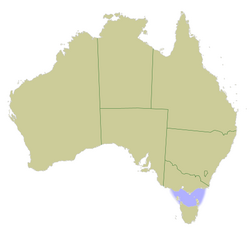Bass Strait Triangle

This article includes a list of general references, but it lacks sufficient corresponding inline citations. (April 2009) |
The Bass Strait Triangle is the waters that separate the states of Victoria and Tasmania, including Bass Strait, in south-eastern Australia. The term Bass Strait Triangle (inspired by the Bermuda Triangle) appears to have been first used[citation needed] following the Valentich Disappearance in 1978 although the region had a bad reputation (never ascribed to supernatural forces, however) long before that.
Geography of Bass Strait
Bass Strait is a generally shallow (average depth of 50 m (160 ft)) stretch of water approximately 300 km (190 mi) wide and 200 km (120 mi) from north to south, encompassed by the entire northern coastline of Tasmania and central to Victoria's eastern coast. The prevailing winds and currents are westerly, the latter being divided by King Island, Tasmania at the western entrance to the strait, causing unpredictable sea conditions, especially when strong winds occur. For example, strong southerly winds can cause a strong northerly current reflecting from the Victorian coast. The combination of winds, currents, tidal flow and the shallow bottom often lead to tall waves, often of short length, with a confused short swell often conflicting in direction.
All shipping to the busy ports of Melbourne, Stanley, Burnie, Devonport, Bell Bay and Launceston and the Bass Strait islands such as King Island and Flinders Island must pass through Bass Strait, and it is also the route of choice for many ships passing from the Australian west to east coasts. Most air traffic between Tasmania and the Australian mainland flies at least in part over or adjacent to it.
Marine incidents
Bass Strait was discovered following the wreck of the ship Sydney Cove in 1797[citation needed] and one of the vessels engaged in the salvage operation, the sloop Eliza, went missing on her return voyage to Sydney. Hundreds of vessels[citation needed] up to the size of bulk carriers[citation needed] have come to grief in Bass Strait since that time through hitting reefs, running aground on the coastline or on river bars while entering port, or foundering due to stress of weather, some dozens being lost without a trace.[citation needed]
Actual north-south (and vice versa) crossing of Bass Strait seldom occurred until after Melbourne was established in 1835. From 1838-1840, at least seven vessels were lost with all hands on their way to or from the new settlement, wreckage from only three being identified. Rumours that some of these vessels had fallen victim to wreckers appear baseless, the main cause probably being bad weather and poor charts. Over the next 100 years, dozens of other vessels have gone missing after entering the Straits, many without trace. One of the most significant disappearances was that of the British warship HMS Sappho in 1858, in which well over one hundred lives were lost.
Aviation incidents
The first aircraft to go missing in Bass Strait[citation needed] was a military Airco DH.9A that was engaged in a search for the missing schooner Amelia J in 1920 — it was believed to have gone into the sea off the southern coast of Flinders Island.[citation needed]
One of the first Bass Strait airliners, the De Havilland Express Miss Hobart, went missing soon after entering service in 1934, only a small amount of wreckage being found on the Victorian coast. A year later, a similar aircraft was lost with all on board off Flinders Island. The cause of both accidents was probably a combination of human error with the known poor design of the aircraft.[citation needed]
During the Second World War, several aircraft — mostly RAAF Bristol Beaufort bombers — were lost during exercises in Bass Strait while on training flights out of air bases, mainly RAAF Base East Sale near Sale, Victoria. These accidents were probably caused[citation needed] by the inexperienced crew crashing into the sea while performing low-level bombing practice — similar accidents occurred over land.
In 1972, a De Havilland Tiger Moth flown by Brenda Hean and Max Price disappeared on a flight from Tasmania to Canberra as part of protests against the flooding of Lake Pedder for a hydroelectricity scheme. It was believed to have crashed at sea somewhere between the East Coast and Flinders Island.[citation needed] Sabotage by pro-development interests was alleged.[1]
The most famous incident,[citation needed] and the one that has been the inspiration for paranormal explanations, was the Valentich Disappearance in 1978.
References
- ^ Millwood, Scott (2008) Whatever happened to Brenda Hean? Crows Nest, NSW. Allen and Unwin. ISBN 978-1-74175-611-1 — based on the research into the documentary of the same name — has some material regarding the suspicions.
Notes
- Broxam & Nash, Tasmanian Shipwrecks, Volumes I and II, Navarine Publishing, Canberra, 1998 and 2000, ISBN 0-9586561-5-0 and ISBN 0-9586561-6-9
- Kevin Killey and Gary Lester, The Devil's Meridian, Lester-Townsend, 1980, ISBN 0-949853-01-1
- Macarthur Job, Air Crash, Volume One, Aerospace Publications, Canberra, 1991, ISBN 1-875671-11-0
- Jack Loney, Mysteries of the Bass Strait Triangle, Neptune Press, 1st ed. 1980. 3rd ed. 1984 (ISBN 0-9091315-3-8)
External links
- Australia Broadcasting Corporation: transcript of TV program on the disappearance of Brenda Hean and Max Price. http://www.abc.net.au/tv/rewind/txt/s1173814.htm
